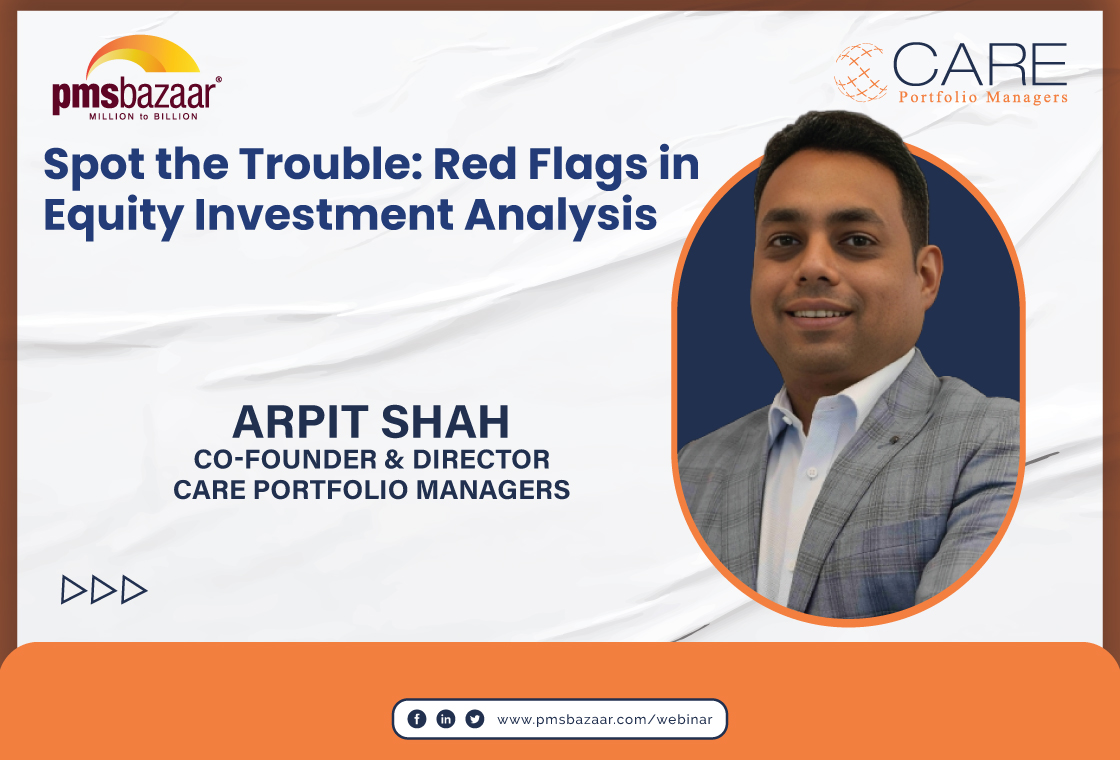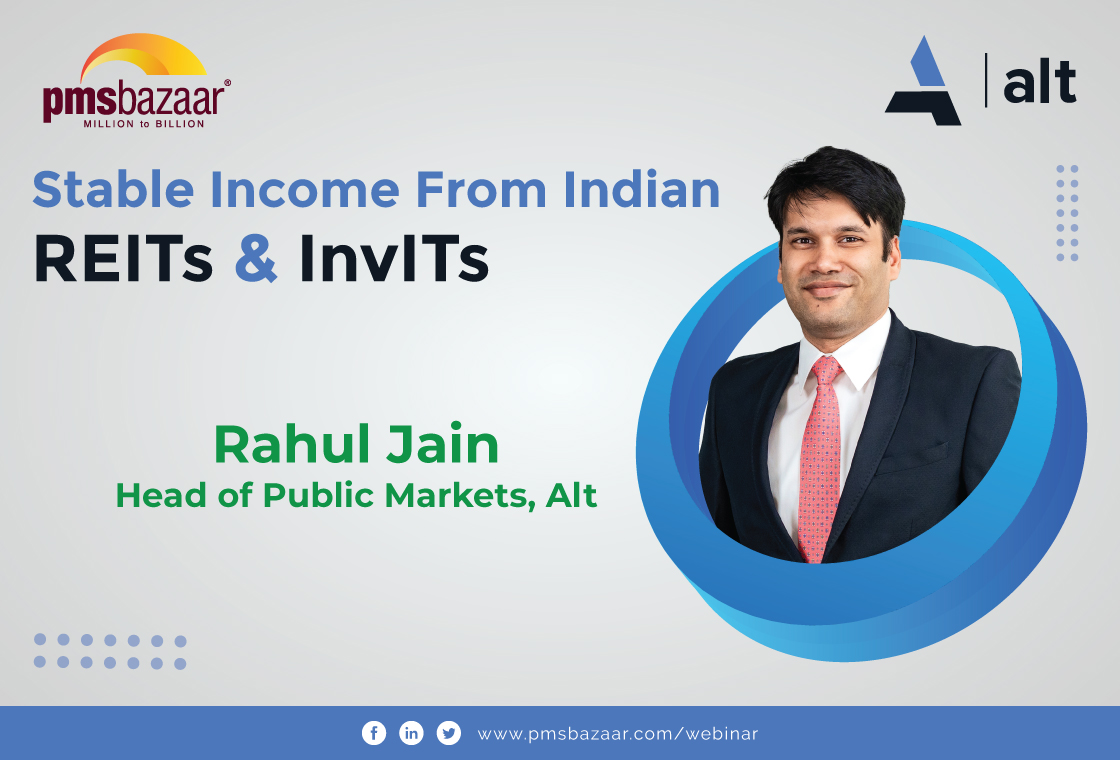As a part of the Alternates Universe Webinar Series, PMS Bazaar, in association with Sundaram Alternates, recently conducted an Exclusive Webinar with Ashish Shanker, MD & CEO of Motilal Oswal Private Wealth, as the guest speaker. This session was moderated by Industry Experts - Vikaas M. Sachdeva, Managing Director, and Karthik Athreya, Head, Product and Strategy, both from Sundaram Alternates. The discussion revolved around the current situation of the Indian stock market and what lies ahead for Indian equities. This Blog covers some of the key takeaways from this webinar.

Excerpts from the interview:
- Market outlook: A bullish perspective on Indian equities
- Key mid-term trends shaping India's market landscape
- Evaluating investment strategies: the 4C framework and portfolio insights
- Strategic insights: Growth sectors, multi-asset funds, and global economic impact
- Market Outlook: A Bullish Perspective on Indian Equities
Sachdeva initiated the session by asking Ashish the most pressing question on everyone's mind: "Are we headed for a pause or a correction in the stock market? How do the growth prospects and market valuations of Indian equities stack up against their global counterparts?"
Ashish emphasizes the importance of understanding the phase of the market we are in rather than trying to predict its short-term movements. He drew on the wisdom of Howard Knox, who famously said that knowing your market phase is more critical than forecasting its immediate future. Ashish firmly believes that India is currently in a sweet phase, both economically and in terms of the stock market. This perspective is underpinned by strong economic fundamentals and corporate profitability, dispelling the notion that the recent rally is merely driven by intuition or hope.
To illustrate the point, Shanker pointed out the intriguing relationship between market returns and earnings growth. Over the last two years, Indian markets have moved only modestly higher while earnings have seen substantial growth. In fact, earnings are up by about 30%, making the current market 25% cheaper than it was two years ago. With a rosy outlook for earnings in the next three to five years, Shanker firmly believes that the Indian stock market is in a bull market phase. In his view, longer-term investors should view any market correction as a buying opportunity, much like the approach taken during the last significant bull market from 2003 to 2008, which featured several sizeable corrections.
Key Mid-Term Trends Shaping India's Market Landscape
Next, Sachdeva asked about the mid-term trends that investors should be keeping an eye on. Shanker highlighted three significant trends that could shape the Indian market over the next three years. First, he pointed to a resurgence in investments, noting that the previous decade had seen a lower investment-to-GDP ratio, particularly in the private sector. However, this trend is shifting as companies are increasingly focusing on building capacities and infrastructure. The government is playing a crucial role in this through its investments in public infrastructure projects.
Secondly, Ashish Shanker discussed the potential for a demand storm in various consumer categories as India's per capita income grows from USD 2,500 to USD 4,000. This shift could lead to an exponential surge in demand for discretionary items like apparel, automobiles, housing, and travel.
Lastly, he emphasized the opportunities in real estate, noting that strong sales growth and demand for housing are evident in the market. The confluence of these factors, including increased government spending, private capex, and rising consumer demand, positions India for a period of substantial growth.
Evaluating Investment Strategies: The 4C Framework and Portfolio Insights
During the discussion, Karthik Athreya brought up an interesting question regarding the ongoing debate about investing in dollar portfolios versus rupee portfolios. Shanker acknowledged the trend among high-net-worth individuals to diversify their portfolios with dollar assets, driven by factors like global aspirations and overseas education for their children. However, he emphasized the importance of careful consideration when venturing into this space, as it requires a deep understanding of the pros and cons of currency exposure and global investments.
Next, In their discussion, Athreya asked Shanker the fundamental tenets they use to evaluate and recommend fund strategies to their clients. Shanker introduced a framework called the "4C" framework, which was influenced by the writings of Michael Mobizan. Initially applied to equity strategies, it was later extended to fixed-income and alternative investments.
The 4Cs framework is centered around four key factors:
Clarity of Philosophy: This involves assessing whether a manager's style is value-oriented, growth-oriented, or growth-at-a-reasonable-price (GARP).
Consistency of Performance: Instead of just looking at absolute alpha, it was important to examine how consistently a fund manager has generated alpha over time. The more consistent the performance, the more likely investors are to stay invested even during challenging times.
Capabilities: This involves understanding the team's ability to execute their investment strategy effectively. Evaluating the fund manager's team, background, and how they interact with each other is crucial.
Cycles: Assessing whether the fund manager has experienced market cycles, including bear markets, is essential. Understanding how they react during crises is crucial to evaluating their ability to navigate different market conditions.
Shanker highlighted the value of gold as an asset class, particularly during market crises. He recommended allocating 10% to 20% of a portfolio to gold, emphasizing the importance of rebalancing yearly.
Shanker also briefly touched on commodities, noting that investing in global commodities requires a sophisticated understanding of supply and demand dynamics. In contrast, domestic commodities in India are relatively less developed due to regulatory interventions.
Regarding equity investments, Shanker suggested aiming for returns of around 12% above inflation, and the allocation to large-cap, mid-cap, and small-cap stocks would depend on market conditions. Shanker suggests that a well-diversified portfolio might consist of 55% to 60% large-cap stocks and 35% to 40% mid and small-cap stocks. He emphasizes the importance of distinguishing between speculative small-cap stocks and those associated with growing industries and categories, as the latter can offer more stable investment opportunities. However, the precise allocation should consider factors like growth potential and industry dynamics.
In summary, the 4C framework offers a comprehensive approach to evaluating fund managers and investment strategies, emphasizing the importance of philosophy, consistency, capabilities, and experience in navigating market cycles. Additionally, they highlighted the role of gold in diversifying portfolios and provided insights into equity investments and commodities.
Strategic Insights: Growth Sectors, Multi-Asset Funds, and Global Economic Impact
Next, Shanker answered some audience questions. Regarding the growth potential of certain sectors, Shanker pointed out that some categories are expected to experience exponential growth, with stocks within those categories also following suit. He highlighted fintech as one such sector, citing India's strong digital infrastructure and competitive advantage in areas like payments and user experience.
Shanker also discussed the potential for multi-asset funds on the platform. He acknowledged the interest in these funds but raised concerns about taxation, emphasizing that mutual funds offer simplicity and favorable tax treatment. However, he expressed optimism about the future of multi-asset AIFs and alternative investment categories, suggesting that combining different asset categories could yield consistent and stable returns.
On the topic of global economic conditions and their impact on India's markets, Shanker took a contrarian view. He considered the challenges faced by global economies as an advantage for India. Despite potential outflows, he believed that India's status as the fastest-growing large economy in the world makes it an attractive destination for investors seeking growth.
When discussing real estate, Shanker addressed both volume and price dynamics. He noted that while volumes in the real estate market have been recovering, they are far from reaching their potential. On the price front, he mentioned that after a period of stagnation, prices have seen some catch-up but emphasized that affordability remains high, making it a good time for consumers to buy homes. He also shared his experience with real estate debt funds and their performance in micro markets.
Lastly, when asked about his long-term outlook on large-cap IT companies, Shanker positioned them as stable assets within a portfolio due to their ability to provide consistent cash flows. He acknowledged the price arbitrage between Indian and global IT and suggested that this trend could accelerate due to the shift towards remote work and outsourcing.
The webinar panel discussed all the above-mentioned points and more. Watch the entire session with the appended link below -
Get access to rich data and analytics of PMS & AIF by subscribing to us. Join the 55000+ investors & experts now: Subscribe NOW
Recent Blogs
.jpg)
Passively Active Investing — A Modern Investor’s Lens on ETF-Based PMS
PMS Bazaar recently organized a webinar titled “Passively Active Investing — A Modern Investor’s Lens on ETF-Based PMS,” which featured Mr. Karan Bhatia, Co-Founder and Co-Fund Manager , Pricebridge Honeycomb ETF PMs. This blog covers the important points shared in this insightful webinar.

Spot the Trouble: Red Flags in Equity Investment Analysis
PMS Bazaar recently organized a webinar titled “Spot the Trouble: Red Flags in Equity Investment Analysis,” which featured Mr. Arpit Shah, Co-Founder & Director, Care Portfolio Managers. This blog covers the important points shared in this insightful webinar.

Long-Only AIFs Rebound Sharply in October; Long-Short Strategies Lag Despite Lower Volatility
106 long-only AIFs averaged 3.68% vs 32 long-short AIFs at 2.7%; only 24–31% of funds beat key indices

Markets log strongest monthly gains in 7 months; PMS performance turns near-uniform in October
Nifty 50 TRI gained 4.62%, BSE 500 TRI rose 4.27%; 415 of 427 equity PMSes ended positive

How SMEs are Shaping India’s Investment Landscape?
PMS Bazaar recently organized a webinar titled “How SMEs are Shaping India’s Investment Landscape?” which featured Mr. Shrikant Goyal, Fund Manager, GetFive Opportunity Fund.

Stable Income from Indian REITs and InvITs
PMS Bazaar recently organized a webinar titled “Stable Income from Indian REITs and InvITs,” which featured Mr. Rahul Jain, Head of Public Markets, Alt.

5 Key Considerations Before Investing in AIFs in India
Alternative Investment Funds (AIFs) have emerged as a compelling option for sophisticated investors seeking diversification and potentially superior returns. But venturing into AIFs requires a clear understanding of their unique characteristics that go beyond simply knowing what they are and their categories.

How AIF can help in diversification?
Traditionally, Indian investors have relied on a mix of stocks and bonds to build their wealth. While this approach offers diversification, it can still leave your portfolio vulnerable to market fluctuations. Enter Alternative Investment Funds (AIFs), a dynamic asset class gaining traction for its ability to unlock diversification beyond the realm of conventional options.

